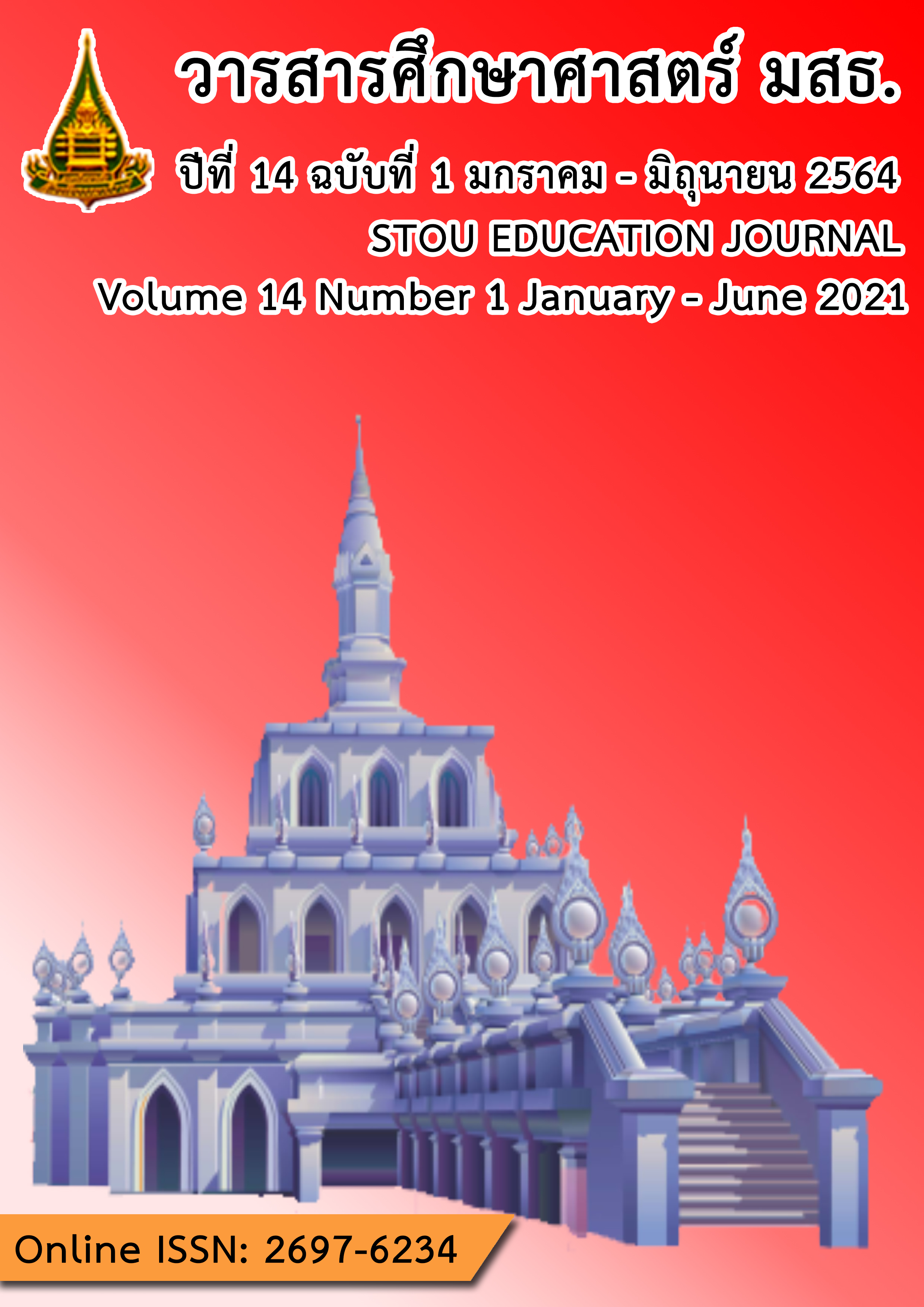The Development of Knowledge and Ability for Activity Management to Develop Preschool Children’s Analytical Thinking with Graphic Organizers for Preschool Teachers in Bangkok Metropolis and Vicinity
Main Article Content
Abstract
The research objectives were 1) to compare knowledge and understanding of preschool teachers in Bangkok metropolis and vicinity before and after undertaking the training on provision of activities to develop preschool children’s analytical thinking with graphic organizers; 2) to investigate preschool teachers’ abilities on provision of activities after undertaking the training; 3) to investigate the preschool teachers’ satisfaction towards the training. The sample comprised 25 preschool teachers, responsible for teaching children aged 4-6 years, in early childhood setting of the 2020 academic year in Bangkok metropolis, Nonthaburi, and Pathum Thani province, obtained by voluntary and be able to attend 2 days of training. The employed instruments consisted of the training package, a test to measure the preschool teachers’ knowledge and understanding on provision of activities, an evaluation form for assessment of preschool teachers’ abilities on provision of activities, and the training satisfaction evaluation form. Statistics employed were the mean, standard deviation, t-test, and content analysis. Research findings showed that 1) the knowledge and understanding of preschool teachers in provision of activities to develop preschool children’s analytical thinking with graphic organizer were significantly higher than their pre – training counterparts at the .01 level; 2) the abilities of preschool teachers in provision of activities was at the highest level. Teachers were able to design various activities cooperating the use of graphic organizer and to use appropriate graphic organizer to encourage analytical thinking. However, when using graphic organizer, they overlooked the using of the positioning, lines, colors, shapes, and pictures in representing and connecting ideas that would help in clarifying and understanding concepts; and 3) the preschool teachers rated their satisfaction towards the training at the highest level.
Article Details
References
คณะกรรมการร่างรัฐธรรมนูญ. (2563). รัฐธรรมนูญแห่งราชอาณาจักรไทย พุทธศักราช 2560. สืบค้นจาก https://cdc.parliament.go.th/draftconstitution2/more_news.php?cid=87
คณาจารย์วิชาเอกปฐมวัยศึกษา. (ม.ป.ป.) คู่มือวิทยากร การอบรมชุดวิชา ประสบการณ์วิชาชีพการพัฒนาเด็ก ปฐมวัย. วิชาเอกปฐมวัยศึกษา สาขาวิชาศึกษาศาสตร์ มหาวิทยาลัยสุโขทัยธรรมาธิราช.
ชนิพรรณ จาติเสถียร, กันตวรรณ มีสมสาร, และอภิรดี ไชยกาล. (2560). วิกฤตปฐมวัยและแนวทางแก้ไข. กรุงเทพฯ: พลัสเพลส.
ชัยยงค์ พรหมวงศ์. (2555). หน่วยที่ 2 สามัญทัศน์สื่อสารการสอนและการฝึกอบรม. ใน ประมวลสาระชุดวิชาเทคโนโลยีและสื่อสารการสอนและการฝึกอบรม (น. 1 - 42). นนทบุรี: สำนักพิมพ์ มหาวิทยาลัยสุโขทัยธรรมาธิราช.
ฐิตพัฒน์ สตางค์จันทร์, ภัทรธิรา ผลงาม, ภัทราพร เกษสังข์, และจุลดิษฐ อุปฮาต. (2560). การพัฒนากิจกรรมส่งเสริมการเรียนรู้ในศตวรรษที่ 21 ของนักเรียน โรงเรียนในสังกัดสำนักงานเขตพื้นที่การศึกษา ประถมศึกษาเลย เขต 2. Veridian E-Journal, Silpakorn University. 10(3), 2152-2173.
ณัฐฐา สีเขียว. (2558). ผลของการเล่านิทานโดยใช้ผังความคิดตามแนวคิดของโทนี่ บูซาน ที่มีต่อการเข้าใจความของเด็กอนุบาล. Online Journal of Education, 11(1), 80-94.
ดาริน บุญพรมมา, ศิริ ถีอาสนา, และเนตรชนก จันทร์สว่าง. (2556). การพัฒนาครูเพื่อพัฒนาทักษะการคิดวิเคราะห์ของนักเรียนโรงเรียนบ้านเม่นใหญ่ สํานักงานเขตพื้นที่การศึกษามหาสารคาม เขต 1. (วิทยานิพนธ์ปริญญาดุษฎีบัณฑิต ไม่ได้ตีพิมพ์). คณะครุศาสตร์ มหาวิทยาลัยราชภัฏมหาสารคาม, มหาสารคาม.
ประดินันท์ อุปรมัย. (2553). หน่วยที่ 4 มนุษย์กับการเรียนรู้ ใน เอกสารการสอนชุดวิชา พื้นฐานการศึกษา.(พิมพ์ครั้งที่ 33, น. 117-166) นนทบุรี: สำนักพิมพ์มหาวิทยาลัยสุโขทัยธรรมาธิราช.
ปิยะนันท์ หิรัณย์ชโลทร. (2561). การพัฒนาการจัดประสบการณ์การเรียนรู้ของครูปฐมวัยเพื่อส่งเสริมทักษะการคิดสำหรับเด็กอายุ 3-4 ปี. วารสารศิลปากรศึกษาศาสตร์วิจัย, 10(2), 48-64.
ผู้จัดการออนไลน์. (2554). การประชาพิจารณ์ เรื่อง การศึกษามาตรฐานวิชาชีพครูปฐมวัย. มหาวิทยาลัยราชภัฏ สวนดุสิต. สืบค้นจาก www.manager.co.th
วาสนา ทวีกุลทรัพย์. (2555). หน่วยที่ 9 การฝึกอบรมแบบกลุ่มใหญ่และกลุ่มเล็ก ใน ประมวลสาระชุดวิชา เทคโนโลยีและสื่อสารการสอนและการฝึกอบรม หน่วยที่ 8-15 (น. 1-53) นนทบุรี: สำนักพิมพ์มหาวิทยาลัยสุโขทัยธรรมาธิราช.
วิมวิภา วิบูลชาติ, และปิยะนันท์ หิรัณย์ชโลทร. (2560). ผลของการจัดกิจกรรมการใช้คำถามประกอบผังกราฟิกที่มีต่อการคิดวิเคราะห์ของเด็กปฐมวัย. วารสารศึกษาศาสตร์ปริทัศน์, 32(2), 104-109.
ศศิลักษณ์ ขยันกิจ. (ม.ป.ป). ปฐมวัย: รากฐานสำคัญของการพัฒนาทรัพยากรมนุษย์. สืบค้นจาก https://www.qlf.or.th/Mobile/Details?contentId=1009
สำนักงานกองทุนสนับสนุนการสร้างเสริมสุขภาพ. (2558). เปิดสถานการณ์เด็กปฐมวัย มุ่งติวตั้งแต่วัยอนุบาล. สืบค้นจาก thaihealth.or.th
สำนักงานเขตพื้นที่การศึกษาประถมศึกษาชลบุรี เขต 3. (2562). การจัดการเรียนรู้ที่เน้นทักษะกระบวนการคิด. สืบค้นจาก https://sites.google.com/site/thinkcon3unit1/title-unit-3/unit-3-3content
สำนักงานคณะกรรมการพัฒนาการเศรษฐกิจและสังคมแห่งชาติ. (2563). แผนพัฒนาเศรษฐกิจและสังคมแห่งชาติ ฉบับที่สิบสอง พ.ศ. ๒๕๖๐ – ๒๕๖๔. สำนักนายกรัฐมนตรี สืบค้นจากhttps://www.nesdc.go.th/ewt_dl_link.php?nid=6422
สำนักงานปลัดกระทรวงศึกษาธิการ. (2555). แผนพัฒนาการศึกษาของกระทรวงศึกษาธิการ ฉบับที่ 11 พ.ศ. 2555-2559. กรุงเทพฯ: สำนักงานปลัดกระทรวงศึกษาธิการ.
สุมนา ระบอบ. (2552). การสอนสังคมศึกษาโดยใช้ผังกราฟิก (Graphic Organizers). ม.ป.ท.
อรพรรณ บุตรกตัญญู, ปัทมาวดี เล่ห์มงคล, ชลาธิป สมาหิโต, เพ็ญศรี แสวงเจริญ, และปิยะนันท์ หิรัณย์ชโลทร. (2560). การพัฒนาหลักสูตรดุษฎีบัณฑิต สาขาปฐมวัยศึกษา คณะศึกษาศาสตร์ มหาวิทยาลัยเกษตรศาสตร์. มหาวิทยาลัยเกษตรศาสตร์, กรุงเทพฯ.
อรุณี หรดาล. (2563). หน่วยที่ 1 แนวคิดการส่งเสริมการคิดเด็กปฐมวัย. ในเอกสารประกอบการสอนชุดวิชาการพัฒนาเด็กปฐมวัยด้านการคิด (น. 1- 60). นนทบุรี : สำนักพิมพ์มหาวิทยาลัยสุโขทัยธรรมาธิราช.
Clark, J. H. (1991). Using Visual Organizer to Focus on Thinking. Journal of Reading, 34(7), 526- 534.
Heckman, J. J. (2011). The economics of inequality: The value of early childhood education. American Educator, Spring, 31- 47.
Hohmann, M. & Weikart, D. P. (2002). Educating young children: Active learning practices for preschool and child care programs (2nd ed.). The United States: High/Scope Press.


